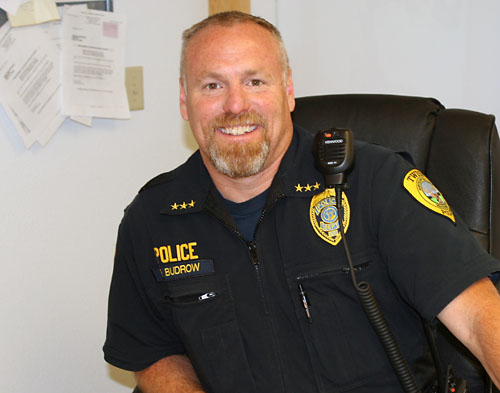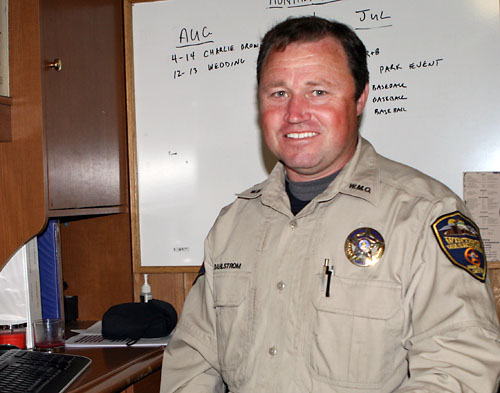 Paul Budrow, Twisp Police chief, has been on the job since March.
First, the good news: there have been no reports of anyone cooking methamphetamine in makeshift laboratories in the Methow Valley. That’s largely thanks to a tough state law governing the sale of the ingredients needed to make this particularly vicious illegal drug, according to local law enforcement officials.
“It’s really had a great impact,” says Brad Wilson, commander of the five-person North Central Washington Narcotics Task Force in Okanogan.
The bad news is that it’s not possible for law enforcement to keep an eye on everything that goes on in rural areas. So it’s fair to say that “We don’t know” if there are meth operations in the valley, concedes Wilson.
Twisp Police Chief Paul Budrow, who’s been on the job since March, and Winthrop marshal David Dahlstrom, who’s been with the department for four years, both say each town in recent years has made just one arrest on a meth charge, and those were for possession or attempted sale.
But even though there seem to be few local producers, there are still meth users, they stress. “Super labs” in Mexico are the source of most of the meth that reaches our area. But the Methow is not a large, lucrative market for selling the drug, noted Budrow, so there hasn’t been as much marketing activity here as there is on the west side of the Cascades.
“It’s about making money,” says Wilson.
 David Dahlstrom, Winthrop marshal, says state law makes it difficult to obtain ingredients to cook methamphetamine.
Meth comes in powder or crystal form. It can be injected via needles, smoked, sniffed or swallowed. It makes people paranoid and violent and, if they’re making it themselves, stinky.
“They smell like cat urine. These are not clean people,” says Wilson. Their teeth become discolored, they itch, and they may have burn scars or open sores on their hands. The health effects are many: liver, kidney and gastrointestinal damage, convulsions and cancer. This is because the ingredients used to make meth are highly toxic and potentially lethal.
The risk of explosions and fire is high in meth labs, and law enforcement officials say that for every pound of meth produced, six pounds of toxic waste remains to contaminate the environment.
One problem for the meth addict is that after the first high, users “can’t ever reach that high again,” explains Dahlstrom, who says they are prone to “extremely violent behavior.”
Citizens who fear they have a meth lab in their neighborhood or hikers who think they’ve stumbled on one in the woods should be alert for certain signs, according to law enforcement officials. The first give-away may be a smell resembling cat urine, or that occupants of a house always come outside to smoke to avoid explosions of the dangerous chemicals they’re mixing.
Pyrex or Corning dishes, jugs and bottles, paper towels, coffee filters, thermometers, cheesecloth, funnels, blenders, rubber tubing and gloves, buckets, gas cans, clamps, aluminum foil, propane cylinders, measuring cups, towels and bed sheets are among the telltale signs of a possible meth lab.
The chemical stew mixed by producers consists of many toxic ingredients used for other purposes: alcohol, ether, red phosphorus (matches and road flares), iodine, trichloroethane (a gun scrubber), sodium metal, sodium hydroxide, ephedrine (a cold medicine), toluene (brake cleaner), sulfuric acid (drain cleaner), lithium (batteries), methanol/alcohol (gasoline additive), anhydrous ammonia (farm fertilizer), pseudoephedrine (cold tablets), acetone and kitty litter.
Anyone who suspects a meth lab operation should not attempt to contact the suspects but call law local enforcement authorities or the narcotics task force at 800-585-0620. If citizens stumble on a suspicious site in the woods, they should photograph it or record GPS coordinates if that’s safely possible, says Budrow. Don’t touch anything that’s lying around the site, and leave quickly.
Other than alcohol, marijuana and prescription drugs are the biggest drug abuse problems in the valley, according to the officers. Prescribed painkillers such as Oxycontin and Vicodin are sometimes illegally sold by people who may even intentionally injure themselves in order to get a doctor’s prescription for the drug, Budrow says.
Wilson and Budrow note that it’s tougher to make drug use arrests in the valley than in urban areas because the valley’s community of drug users is more tightly knit. Since everyone knows one another, no one wants to rat on anyone else, they say. “They won’t talk,” says Budrow.
The Methow has attracted criminals who run large-scale marijuana growing operations in the forests, typically tended by illegal Mexican immigrants who have no idea who owns the plants. Budrow says that, as in the past, the National Guard will once again conduct a grid-by-grid flyover of the valley prior to the fall marijuana harvest season. |
